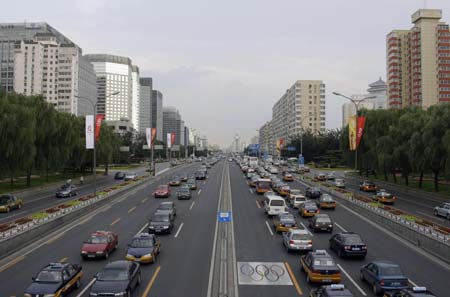BEIJING - It was anything but easy to travel around Beijing, a sprawling city with 3.36 million motor vehicles, but authorities are hoping to reverse the traffic woes -- at least for the upcoming Olympics and Paralympics.

Vehicles run on the West 2nd Ring Road during rush hour in Beijing July 20, 2008. The lanes besides the central fence are reserved for Olympic traffic. [Agencies]
|
Altogether 7,000 automobiles will be serving the Games in Beijing, according to the transport department of the Beijing Organizing Committee of the 29th Olympic Games (BOCOG).
While cars and buses carrying athletes, coaches and Olympic officials from across the world will run along exclusive lanes with no fear of congestion, accredited journalists, with just a show of their passes, enjoy free bus rides connecting all competition venues, official media hotels across Beijing, two media villages, the Main Press Center (MPC) and the International Broadcast Center (IBC).
Beijing Public Transport Holdings Ltd, a state company that runs more than 25,000 buses and 823 routes in the Chinese capital, has allocated nearly 900 air-conditioned buses to serve the Games reporters.
"More than 1,000 drivers are working on shifts to provide media transport services around the clock," said Shang Zhiquan, deputy coordination manager for media transport with the BOCOG.
All the drivers have stood out in written, road tests and interviews. "Among the basic requirements are five years of bus driving experience, zero record of road accident, and average age around 40," said Shang, also an executive with Beijing Public Transport Holdings Ltd.
The buses run on 63 routes, a network connecting two media villages, 42 media hotels, more than 30 competition venues in Beijing and the MPC and IBC near the Olympic Village.
The routes have been scrutinized and have to be followed strictly.
"No, you're not allowed to change route without authorization," Shang told a driver who suggested a seemingly better route from the MPC to a competition venue.
The driver, who declined to be named, said he could have shortened the travel time by switching to a route with fewer traffic lights. "Some passengers complained it took longer than expected."
The buses, all brand new and in good condition, normally drive at an average speed of 50 km per hour for safety considerations. The Second Ring Road in the city center allows a maximum speed of 80 km per hour.
"A group of British journalists told me the other night our services were 'very impressive' and better than other Olympic cities they had been to," said Shang.
In response to an influx of journalists traveling between the media village and the MPC/IBC in the morning and afternoon, transport coordinators have adjusted the schedules by cutting the intervals from 60 to 30 minutes in the peak hours from 6 a.m. to 10 a.m., and from 6 p.m. to 10 p.m.
"The schedule is subject to further changes as of August 1, when more journalists are expected to commute between the media village and the MPC/IBC," said Ren Xue, a BOCOG clerk in charge of transport coordination at the MPC.